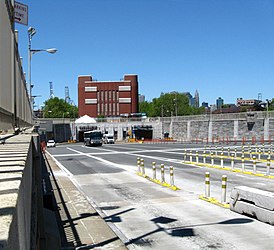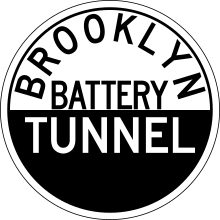Brooklyn-Battery Tunnel
aus Wikipedia, der freien Enzyklopädie
| Brooklyn-Battery Tunnel | ||
|---|---|---|
 Das Tunnelportal in Brooklyn
| ||
| Offizieller Name | Hugh L. Carey Tunnel | |
| Nutzung | Straßentunnel | |
| Verkehrsverbindung | Interstate 478 | |
| Ort | New York City | |
| Länge | 2779 m | |
| Anzahl der Röhren | 2 (jeweils zweispurig) | |
| Bau | ||
| Baubeginn | 28. Oktober 1940 | |
| Fertigstellung | 25. Mai 1950 | |
| Lagekarte | ||
|
| ||
| Koordinaten | ||
| NW-Portal in Manhattan | 40° 42′ 18,7″ N, 74° 0′ 55″ W | |
| SO-Portal in Brooklyn | 40° 40′ 51,8″ N, 74° 0′ 17,8″ W | |
Der Brooklyn-Battery Tunnel (offiziell Hugh L. Carey Tunnel) ist ein mautpflichtiger Straßentunnel unter dem East River mit zwei Röhren und insgesamt vier Spuren, der die New Yorker Stadtteile Manhattan und Brooklyn auf Long Island miteinander verbindet.




Der am 25. Mai 1950 eröffnete Tunnel wurde unter der Nordostspitze der Governors Island hindurchgeführt, auf die allerdings nur ein Zu- und Abluftstollen führt. Mit seinen 2779 m Länge unter dem New Yorker Hafen ist er der längste unter Wasser gebaute Fahrzeugtunnel in Nordamerika. Er bildet den Kern der Interstate 478 im Verlauf zwischen Interstate 278 und der New Yorker Staatsstraße 9A (NY-9A), West Side Highway aus Richtung World Trade Center. In Süd-Brooklyn trennt seine Mündung und die Zufahrt das Hafengebiet Red Hook vom nördlich gelegenen Carroll Gardens.
Betrieben wird er von der Triborough Bridge and Tunnel Authority. Der Bauentwurf stammt von Ole Singstad. Mit dem Bau wurde am 28. Oktober 1940 begonnen, durch den Zweiten Weltkrieg wurde seine Fertigstellung um Jahre verzögert.
Am 8. Dezember 2010 beschloss die New Yorker Regierung, den Brooklyn–Battery Tunnel nach dem ehemaligen Gouverneur Hugh Carey zu benennen. Die Umbenennung in Hugh L. Carey Tunnel erfolgte offiziell am 22. Oktober 2012.[1]
Am 29. Oktober 2012 wurde der Tunnel infolge des Hurrikans Sandy vollständig geflutet.
Literatur
[Bearbeiten | Quelltext bearbeiten]- Robert A. Caro: The Power Broker: Robert Moses and the Fall of New York. New York, Knopf, 1974.
Weblinks
[Bearbeiten | Quelltext bearbeiten]Nachweise
[Bearbeiten | Quelltext bearbeiten]Text is available under the CC BY-SA 4.0 license; additional terms may apply.
Images, videos and audio are available under their respective licenses.

